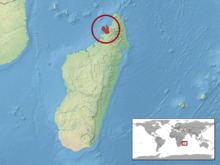Class Reptilia Suborder Lacertilia | Phylum Chordata Rank Species | |
 | ||
Similar Phelsuma breviceps, Yellow‑throated day gecko, Phelsuma kely, Phelsuma modesta, Flat‑tailed day gecko | ||
Seipp's day gecko (Phelsuma seippi ) is a diurnal species of gecko. It lives in northern Madagascar, typically inhabits rainforests, and dwells on trees. Seipp's day gecko feeds on insects and nectar.
Contents
Etymology
The specific name, seippi, is in honor of German herpetologist Robert Seipp.
Description
Phelsuma seippi belongs to the medium-sized day geckos. It can reach a total length (including tail) of about 14 cm (5.5 in). The body colour of this slender and long-snouted gecko is green or yellowish green. There are several small red or rust-coloured spots on the back which may form dorsal striping. A rust-coloured eye stripe extends from the nostril to above the ear opening. A red v-shaped marking may be present on the head. Typical for this species are several v-shaped stripes on the throat. The ventral side is light pink.
Geographic range
P. seippi inhabits northwest Madagascar. It can also be found on the islands Nosy Bé and Nosy Komba.
Habitat
Phelsuma seippi is restricted to the native rainforests and avoids bright sun light. It lives on trees both in the forest and along its edges.
Diet
P. seippi feeds on various insects and other invertebrates. It also likes to lick soft, sweet fruit, pollen and nectar.
Behaviour
This Phelsuma species is often found in pairs on a tree. Juveniles mainly inhabit surrounding low shrubs.
Reproduction
The female of P. seippi lays a pair of eggs and hides them on the ground under foliage or wood, or she may lay her eggs on trees under loose bark. At a temperature of 28 °C (82.4 °F), the young will hatch after approximately 45–50 days. The juveniles measure 40 mm (1.6 in).
Care and maintenance in captivity
P. seippi should be housed in pairs in a well planted terrarium. The temperature should be between 25 and 28 °C (77 and 82.4 °F). The humidity should be maintained between 75 and 100%. In captivity, P. seippi can be fed with crickets, wax moth larvae, fruit flies, mealworms, and houseflies.
